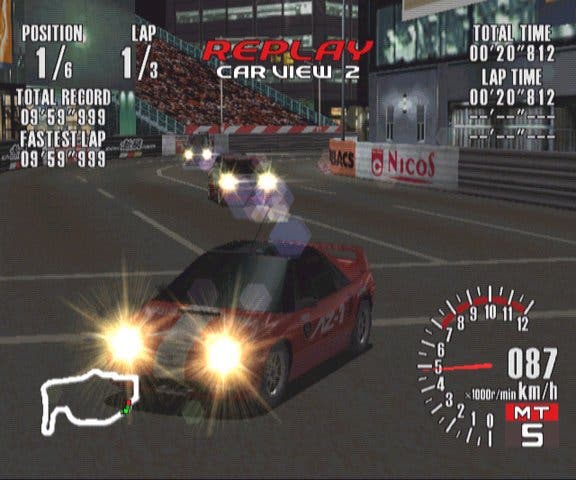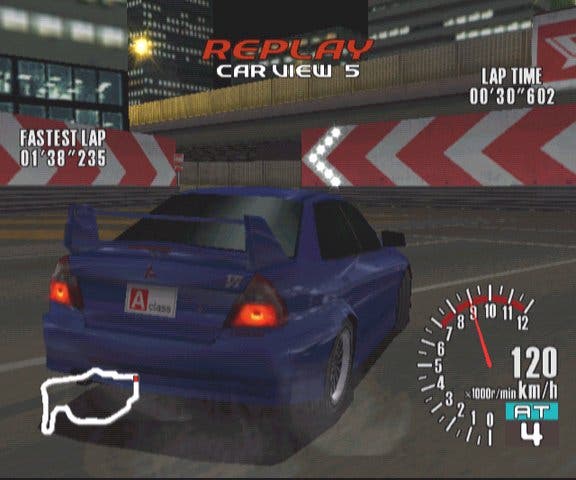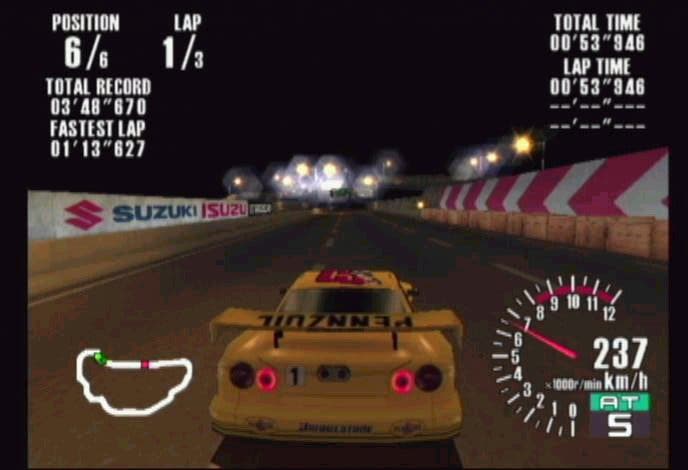Sega GT
Review - a bad game at a bad time? Blunder of the year award at the ready, chaps

"GT"
One of the things that was evident to people who played Gran Turismo when it burst onto the gaming scene several years ago was that it was the kind of game that would spawn plenty of pretenders. The killer combination of a snug physics engine coupled with one of the most varied reward structures ever completely redefined the racing genre for the better. In fact, the only game that it's fair to say has come close to emulating GT's success since then is Metropolis Street Racer on the Dreamcast, a game that we felt was so utterly complete that we spent the best part of two weeks sweating over what we could find to criticize about it. Which all in all doesn't bode terribly well for Sega GT, which is as you may already have guessed a Gran Turismo clone. In its own right a fairly entertaining title, GT has unfortunately chosen to arrive in the wake of MSR, and during one of the busiest periods of the computerized racing calendar. With Christmas looming, the game really didn't stand a chance, and thanks to some unruly controls and an unintuitive interface, it sealed its own fate. But nonetheless, from the point of view of the average gamer, beguiled into fritting away his Christmas money in the 'Sale' section of the local electronics gaff, it may represent an interesting diversion from the cold turkey sandwiches and stale wines that otherwise occupy one's time. And so here we are, and I don't know about you but the sandwiches are starting to look tempting...

Racey
One of the vast array of issues I have with the current crop of racing games is that far from encouraging a new and innovative style, they all seem to have gotten bored and opted for the same basic configuration. The structure found here is nigh on what was originally conceived by Gran Turismo in 1997. Each potential driver has to undergo a series of rigorous driving tests to secure his or her license, before buying a reasonable beginner's car and racing against a field of drivers whose skills are comparable to your own measly levels of performance. From there you win, earn, reinvest and eventually end up with the biggest, most souped-up car in the field, with top of the range shocks, springs, turbos and furry dice. By winning your way into the three higher classes you also unlock some more powerful motors and gain access to new courses. Sadly though, the interface is laughable and ultimately spoils everything that goes on off-track. For instance, when I first entered Championship mode, there was no immediate advice on what to do. After pondering the screenful of whirring levels and icons, I delved into the manual to discover what was going on. Elsewhere, car selection is awkward and cumbersome, relying on your being in possession of a photographic memory of your car before really allowing you to get anywhere. If you do manage to get out onto the racecourse, you will discover that the tracks, which are wholly original and independent of the real world's own eccentric bumps and blips, are varied in size and location. The time of day can play a large part in the outcome of your race as well, thanks to the often overwhelming lens flare and other elemental distractions. Fans of Indy pursuits (no pun intended) will be happy to hear that those neverending ovals that us Europeans seem to detest make up a reasonable proportion of the tracks on offer. There are more technical courses too, which invite the driver to show off his or her ability to handle the advanced physics of the game, rather than, well, a demonstration of how many revs one can get on the meter before the wheels fall off.

Electric Death
In Japan, when the game was originally released, the punters cried out for a Western revision with an overhauled control system. Players of the original Japanese version will be aware of the fact that in GT, the D-Pad is totally unresponsive, and the analogue stick seems to want to transmit your instructions via carrier pigeon, such is the lag between cause and effect. Although the physics of the game are fairly realistic, the fact that you cannot damage your car should be something of a giveaway that Sega have, instead of improving the control system, opted to tweak the physics engine to be overly forgiving. As such, it's no surprise to find yourself bouncing the car from barrier to barrier with no loss of momentum in your attempts to put it across the finishing line. Getting the car to face forward again is a game of chance, and there were several occasions where I just flung my gamepad down on the floor and gave up. If there's one thing though that driving fanatics will find relatively satisfying about GT, it's the library of licensed cars. Although the allocation here is somewhat less than Gran Turismo 2 gave us last year, the names and model numbers will certainly prove more recognisable for the most part. Top cars like the Supra, Honda S2000 and even a prototype Dodge Viper GTS-R are available to those who reach the highest levels of attainment, and if you're not that patient, a lot of them are also available in the Quick Race and Head-to-Head playmodes. The car models are very accurate, and superbly animated, zooming past you at a fairly consistent 40 frames per second, with plenty of different camera angles to admire the bodywork. Motion blur also makes an appearance, giving the cars a luminescent quality seen as far as I can remember only in obscure places like Gran Turismo's opening video. Pop-up is also fairly minimal throughout, thanks to the powerful 3D engine at the heart of the game.

Almost
Regrettably, as with a lot of things in Sega GT, the graphics are good in some areas, but much worse in others. The textures are, to be frank, atrocious at times, with pixelation at a distance of several metres and on the more unconventional surfaces like cobblestone, a bizarre sort of dancing effect that skewers the display. The sounds, too, are somewhat glitchy, and far too deep and booming, a factor that leads to the entire soundtrack becoming completely muffled. Thanks to the low tone of the engine roars and tyre screeches, it's also fairly noticeable when they repeat, making the process of bouncing your car off every barrier even less enjoyable. If there's one thing that could have saved GT from becoming a real cornerstone of pain for the Dreamcast, it's the Internet capability. The single player AI is fairly formidable and offers a reasonable challenge, but you can also download Ghost cars from the Sega GT website. This feature alone bumped up the level of enjoyment I extracted from GT no end. Playing against other people is fantastic fun, and observing their driving styles and how they contrast your own is quite an interesting experience. I didn't manage to upload my own time trials for some reason, but it was fairly obvious that others were having no trouble with this feature. Ultimately, one of GT's biggest problems is that it feels unfinished. There's a whole host of things the game could be commended for, but almost every point is countered by some looming mass beneath the surface, such as the problems with the graphics engine overshadowing the wonderful car models, and the repetitive sound effects obscuring the fairly impressive rock/techno soundtrack that lurks behind. The only thing that I felt did the game any justice was the Internet options, and even those were quite limited. Given a few months more time on the development slab at Sega, GT could have been one of the best racers of our time, but in their foolishness, they rushed it out of the door in every territory.
Conclusion
A marred effort, is the best appraisal one can give of Sega GT. For all its achievements, there's always something to be disappointed about, and in a genre as tightly packed as this, one ought not to concern one's self with the likes of this. Steer well clear, at least until the powers that be opt for a sequel.

